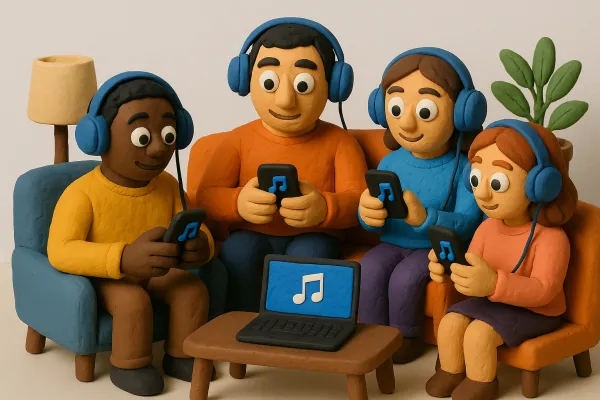Understanding Streaming Payment Structures: Maximizing Your Earnings in the Digital Age

In today's fast-paced digital world, streaming has completely changed how artists earn money from their music. With platforms like Spotify and Apple Music leading the way, understanding the ins and outs of streaming payments is crucial for maximizing your earnings. This article breaks down the complex streaming landscape, explores how royalties work, and offers tips on how to choose the best platform for your music. By the end, you'll have a clearer picture of how to make the most of your music in the streaming age.
Key Takeaways
- Streaming has transformed the music industry, making it easier for artists to reach global audiences.
- Understanding how much you earn per stream varies by platform, so it's vital to do your homework.
- Different platforms have different payout structures, impacting your overall earnings significantly.
- Always read the fine print in streaming contracts to protect your rights and revenue.
- Diversifying your income through live shows and merchandise can supplement your streaming earnings.
Understanding The Streaming Landscape
We're going to break down the streaming world. It's changed music forever, and it's important to get how it all works. Let's get started.
The Rise Of Streaming Platforms
Streaming platforms have exploded in popularity. It's hard to remember a time before them, right? They've become the main way people listen to music. Back in 2022, streaming made a crazy $24.5 billion globally, which was like 62% of all the money in the music business. Platforms like Spotify, Apple Music, and Amazon Music are leading the charge, with tons of users all over the world.
What Counts As A Stream?
So, what is a stream, anyway? It's not just hitting play for a second. Usually, a platform counts it as a stream if someone listens for at least 30 seconds. If it counts, the people who own the rights to the song get a little bit of money. It's not much, but it adds up, hopefully!
The Global Impact Of Streaming
Streaming isn't just a US thing, it's everywhere. It's changed how music is made, distributed, and listened to all over the planet. It's opened up new markets for artists, but it's also created some challenges. For example, payout structures can be confusing. It's a whole new world, and we're all trying to figure it out together.
Streaming has totally changed the game. It's not just about listening to music anymore; it's about how artists connect with fans, how music gets discovered, and how everyone gets paid (or doesn't get paid). It's a complex system, and it's constantly changing. We need to stay on top of it to make sure it works for everyone, not just the big companies.
Decoding Royalties And Earning Per Stream
It's time to talk money! Figuring out how much you actually make from streaming can feel like trying to solve a puzzle. There are so many factors at play, and it's not always straightforward. Let's break down the basics of royalties and earnings per stream so we can all get a clearer picture.
How Much Do You Really Make?
Okay, let's get real. The big question is: how much do we actually make per stream? The answer? It varies. A lot. It depends on the platform, your distribution deal, and even where your listeners are located. Generally, we're talking fractions of a cent per stream. It might not sound like much, but it can add up, especially if you're getting a lot of plays. Understanding streaming payouts is key to managing expectations and planning your music career.
The Differences Between Platforms
Each streaming service has its own royalty rates. Some pay more than others, and the way they calculate those rates can differ too. Here's a super simplified look:
- Spotify: Pays out somewhere around $0.003 to $0.005 per stream.
- Apple Music: Generally pays a bit more, around $0.006 to $0.008 per stream.
- YouTube Music: Can be even lower, often around $0.001 per stream.
Keep in mind these are just averages. The actual amount can fluctuate. It's important to do your research and see which platforms align best with your goals. Also, remember that these numbers are constantly changing, so stay updated!
Understanding Royalty Structures
Okay, so how do these platforms actually calculate what they owe us? It's not as simple as just multiplying streams by a fixed rate. Here's a simplified breakdown:
- Revenue Pool: Each platform takes all the money they make from subscriptions and ads and puts it into a big pool.
- Pro Rata Distribution: They then divide that pool among the rights holders based on their share of total streams.
- Deductions: Before we see any money, the platform takes its cut (usually around 30%), and there might be other deductions for things like processing fees.
It's important to remember that streaming royalties are complex. The actual amount we receive depends on a bunch of factors, including the listener's subscription status (premium vs. free), their location, and the agreements we have with our distributors. It's not always easy to predict exactly how much we'll earn, but understanding the basics can help us make informed decisions about our music distribution strategy.
Choosing The Right Platform For Your Music
Okay, so we've all got our music ready to go, but where do we put it? It's not as simple as just throwing it up on every platform and hoping for the best. We need to think strategically about where our music will thrive. Let's break down how to pick the right streaming home for your tunes.
Comparing Payouts Across Services
Let's be real, money matters. We need to understand how much each platform pays per stream. It's not a one-size-fits-all situation. Some services pay more than others, and those rates can change based on a bunch of factors, like where the listener is located and what kind of subscription they have. Doing a little research into music streaming payouts comparison can really open your eyes.
Here's a super simplified example (these numbers fluctuate, so don't take them as gospel):
| Platform | Estimated Payout Per Stream |
|---|---|
| Spotify | $0.003 - $0.005 |
| Apple Music | $0.005 - $0.007 |
| YouTube Music | $0.001 - $0.003 |
Keep in mind that these are just averages. Your actual earnings will vary. Also, don't forget to factor in any fees from distributors or aggregators.
User Base And Exposure Opportunities
It's not just about the money, it's about getting heard! A platform with a smaller payout but a massive user base might actually be better for you in the long run. Think about it: more streams, more potential fans, and more opportunities for growth. Consider where your target audience hangs out. Are they on Spotify all day, or are they more likely to be on YouTube Music?
- Spotify: Huge user base, great for playlist exposure.
- Apple Music: Good for higher payouts, attracts a more engaged audience.
- YouTube Music: Massive reach, potential for video integration.
Don't underestimate the power of a platform's algorithm. Some algorithms are better at promoting new artists than others. Do some digging and see which platforms are known for supporting up-and-coming musicians.
The Importance Of Platform Features
Beyond payouts and user base, think about the features each platform offers. Does it have good analytics so you can track your progress? Does it offer tools for connecting with fans? Does it integrate well with social media? These things can make a big difference in how successful you are at building a following. For example, some platforms offer better options for artists to upload their unique music and artwork, which can be a big plus.
- Analytics: Track your streams, listener demographics, and more.
- Artist Profiles: Customize your profile to showcase your brand.
- Fan Engagement Tools: Connect with your fans through comments, messages, and live streams.
Navigating Streaming Contracts Like A Pro
It's easy to get lost in the excitement of getting your music out there, but understanding the fine print is super important. We've all heard horror stories about artists losing rights or getting stuck in bad deals. Let's make sure that doesn't happen to us!
Key Terms To Look Out For
When we're looking at contracts, there are a few things that should immediately grab our attention. Exclusivity clauses are a big one – do they lock us into only one platform, and for how long? What about termination rights? Can we get out of the deal if things aren't working out? And what's the deal with intellectual property? Who owns what, and what rights are we giving away? These are the questions we need to be asking.
Here's a quick rundown of some key terms:
- Term: How long the contract lasts.
- Territory: Where the contract applies (worldwide, specific countries, etc.).
- Exclusivity: Can you work with other platforms?
- Rights Granted: What rights are you giving the platform (distribution, reproduction, etc.)?
Revenue Sharing Vs. Flat Fees
Okay, so how do we get paid? There are generally two main ways: revenue sharing and flat fees. Revenue sharing means we get a percentage of the money the platform makes from our music. Flat fees are a one-time payment, regardless of how well our music does. Which one is better? It depends! A flat fee might be good if we need money upfront, but revenue sharing could be more lucrative in the long run if our music takes off. It's a gamble, but one we need to understand. Make sure you understand the streaming & digital media contracts before signing.
Protecting Your Rights As An Artist
Protecting our rights is the name of the game. Here are a few things we should always keep in mind:
- Get Legal Advice: Seriously, talk to a lawyer who knows about music contracts. It's worth the investment.
- Negotiate: Don't be afraid to ask for changes to the contract. Everything is negotiable.
- Understand Your Rights: Know what you're giving away and what you're keeping.
It's easy to feel pressured to sign a contract quickly, especially when we're excited about an opportunity. But taking our time, doing our research, and getting good advice can save us a lot of headaches (and money) down the road. Remember, this is our art, our work, and we deserve to be treated fairly.
Maximizing Your Earnings Beyond Streaming
Streaming is cool and all, but let's be real: it's rarely enough to live on. We need to think bigger, outside the box, and find other ways to make money from our music. It's about building a sustainable career, not just chasing streams.
Diversifying Your Income Sources
Don't put all your eggs in one basket! Streaming is just one piece of the puzzle. We need multiple income streams to really thrive. Think about it: if one stream dries up, you've got others to fall back on. It's like investing in high-yield CDs - you want a diverse portfolio.
Here are some ideas:
- Merchandise: T-shirts, posters, stickers – anything your fans will buy to support you.
- Patreon/Subscription Services: Offer exclusive content, early access, or behind-the-scenes stuff for paying subscribers.
- Teaching/Workshops: Share your knowledge and skills with aspiring musicians.
The Role Of Live Performances
Live shows are where it's at! Not only do they bring in money directly through ticket sales, but they also help us connect with our fans on a deeper level. Plus, selling merch at shows is a great way to boost income. Think of live performances as an experience, not just a concert.
Live shows are also a great way to test out new material and get immediate feedback from your audience. It's a chance to refine your songs and see what resonates before you even think about recording them. Plus, the energy of a live crowd is unmatched – it can really fuel your creativity.
Merchandising And Sync Deals
Merch is more than just a t-shirt; it's a statement. It's a way for fans to show their support and feel like they're part of something bigger. And sync deals? Those can be huge! Getting our music placed in movies, TV shows, or commercials can bring in a ton of money and expose us to a whole new audience. It's like getting paid to have people hear our music! We should always be on the lookout for sync licensing opportunities.
The Future Of Streaming Payments
Trends In Payment Structures
Okay, so where are streaming payments headed? It's a wild west out there, but we're starting to see some patterns. One thing is for sure: the old model isn't cutting it for most artists. We're seeing a push for more transparency in how royalties are calculated and distributed. Think about it – wouldn't it be great to actually understand where your money is coming from and how much you're really making?
- More direct payment options are emerging.
- Blockchain tech could revolutionize royalty distribution.
- Subscription models are evolving to include artist support.
The Shift Towards Artist-Centric Models
The biggest trend? A move towards artist-centric models. This means systems that prioritize paying artists fairly, rather than focusing solely on maximizing profits for the platforms. It's about flipping the script and putting the creators first. We're talking about things like user-centric payment systems, where your subscription money goes directly to the artists you listen to most. Imagine that! It's a game-changer.
This shift isn't just about money; it's about power. Artists are demanding more control over their music and their income. They're using social media to connect directly with fans, building communities, and finding new ways to monetize their work outside the traditional streaming system.
What This Means For Creators
So, what does all this mean for us creators? Well, it means we need to stay informed and be proactive. We need to understand the changing landscape and be ready to adapt. It also means we have more power than ever before to shape the future of streaming payments. Let's get educated about music streaming payouts and make our voices heard!
- Stay informed about new payment models.
- Advocate for fair compensation.
- Explore alternative platforms and revenue streams.
As we look ahead, streaming payments are set to change how we handle money online. With faster transactions and easier access, they will make buying and selling smoother for everyone. If you want to learn more about this exciting future, visit our website for the latest updates and insights!
Wrapping It Up
So, there you have it! Streaming payments can be a bit of a maze, but understanding how they work is key to making the most of your music. Whether you're an artist or just someone curious about the industry, knowing the ins and outs of royalties and payouts can really help you boost your earnings. Don't just stick to one platform; explore your options and see where you can get the best bang for your buck. And remember, it’s not just about the streams—live shows and merch can add a nice chunk to your income too. Keep learning, stay savvy, and you'll be on your way to maximizing those earnings in the digital age!
Frequently Asked Questions
What is a music stream?
A music stream happens when someone plays a song on a platform like Spotify or Apple Music. Usually, the song needs to be played for at least 30 seconds to count.
How much money do artists make from streaming?
Artists usually earn a small amount of money for each stream. For example, they might make between $0.003 and $0.008 per stream, depending on the platform.
Which streaming platform pays the most?
Different platforms pay differently. For example, Apple Music often pays a bit more per stream than Spotify, but it also depends on the artist's agreement with the platform.
What should I look for in a streaming contract?
When looking at a streaming contract, pay attention to payment terms, how royalties are calculated, and any restrictions that might limit your rights as an artist.
How can artists earn more money besides streaming?
Artists can earn more by doing live performances, selling merchandise, and getting their music used in movies or TV shows.
What is the future of streaming payments?
The future might see more artist-friendly payment models, meaning artists could earn more from their music as platforms change their payment structures.





